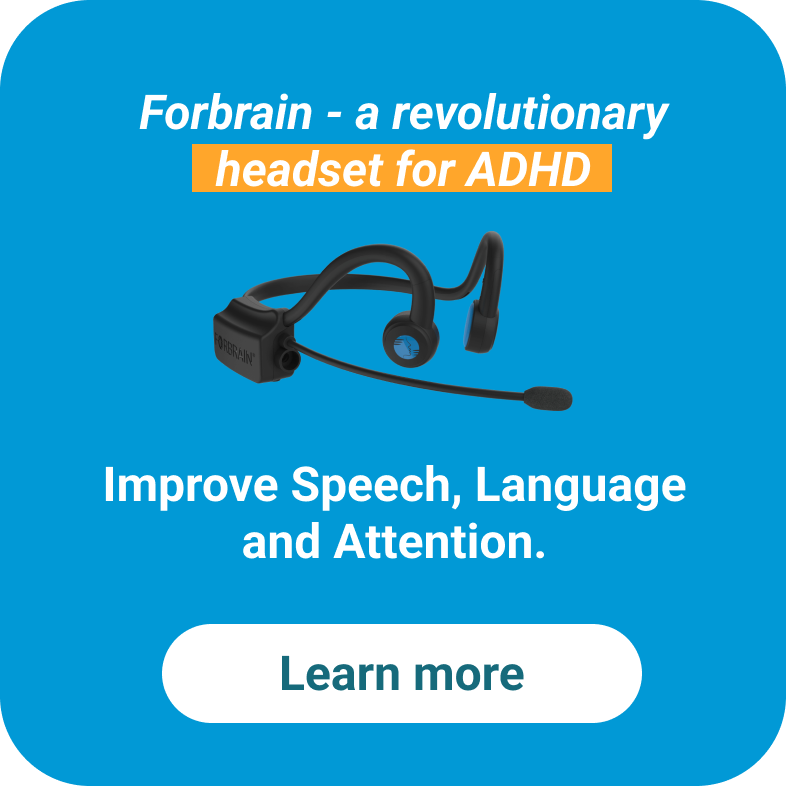IEP for ADHD Explained: A Comprehensive Resource
 Amy Yacoub
Amy Yacoub Speech-Language Pathologist
September 11, 2023

What is an IEP for ADHD? | Does ADHD Qualify for IEP? | Components and Examples of ADHD IEPs | Developing an Effective IEP for ADHD | Using Forbrain
An Individualized Education Plan (IEP) is a personalized plan that outlines the educational goals and support services for students with special needs, such as ADHD. An IEP helps ensure the student receives an inclusive and tailored education.
An IEP is a critical tool in supporting the unique educational needs of students with ADHD. It provides the student with specific accommodations, strategies, and support services that can help them overcome challenges associated with ADHD so that they can maximize their learning potential and thrive academically.
What is an IEP for ADHD?
An IEP for ADHD is a customized roadmap for a student with ADHD that accompanies them on their academic journey.
Students with ADHD are at risk for poor school performance, as they typically struggle with attention, focus, and memory. An IEP outlines certain accommodations and services that take the student’s unique needs into account to support their academic performance.
An IEP specifies the support services that the child will receive, such as classroom accommodations, behavioral interventions, specialized instruction, and therapy services.
The Individuals with Disabilities Education Act (IDEA) is a federal law that mandates special education services and supports for students with disabilities in the U.S. IDEA sets guidelines for developing IEPs for children and encourages collaboration between schools, families, and other service providers. A goal of an IEP is to ensure the best possible educational outcomes for students with disabilities.
Does ADHD Qualify for IEP?
ADHD qualifies for an IEP under the Individuals with Disabilities Education Act (IDEA). In order to qualify, students are required to undergo a comprehensive evaluation to determine whether their ADHD impacts their educational performance.
Various factors such as academic performance, social interactions, behavior, and the need for specialized instruction or related services are considered when determining eligibility for an IEP for a student with ADHD.
Components and Examples of ADHD IEPs
An ADHD IEP typically consists of specific key components which are customized to meet the unique needs of the student. Common components and examples for students with ADHD include:
- Present Levels of Performance. This section will outline the current academic and functional abilities of the students, including their strengths and challenges associated with ADHD.
Example: The student demonstrates challenges sustaining attention during classroom lessons or independent work, which results in incomplete assignments and missed instructions.
- Measurable Goals. Goals tailored to address the unique needs of the student with ADHD are outlined. They should be specific, measurable, achievable, relevant, and time-bound (SMART).
Example: By the end of the academic year, the student will independently complete and submit at least 90% of assigned homework tasks across all subjects.
- Accommodations and Modifications. Specific adjustments to the child’s learning environment, curriculum, or expectations are outlined here.
Example: Preferential seating, the use of assistive technology, extended time allotted to complete assignments.
- Behavior Intervention and Support. Strategies that address behavior challenges related to ADHD are outlined here. This can include positive support plans that are designed to reinforce desired behaviors. This section may also outline techniques that will be implemented to manage the student’s attention difficulty and impulsivity.
Example: Intervention: Visual and auditory cues will be utilized to help the student maintain attention to tasks. Support: A visual timer may be used by the teacher to prepare the student for how long they have to complete an activity. Verbal reminders or signals will be used as auditory cues to refocus the student to tasks.
- Related Services. These are services that will be provided to the student to support his or her academic performance. Services are chosen to address the specific needs of the student with ADHD.
Example: Speech Therapy, Occupational Therapy, and counseling are services that can help a student with ADHD regulate sensory input, improve social-emotional skills, and increase auditory processing, expressive communication, and organization skills.
- Transition Planning. This section addresses the student’s needs as they prepare for their next steps after high school (such as college, attending vocational training, or employment).
Example: A goal here may be for the student to develop strategies to manage social and emotional challenges across various settings. The student can attend social skills groups to enhance their skills in this area, as provided by support from a Speech Therapist or counselor.
- Progress Monitoring and Reporting. Here, the benchmarks and timelines that will be used to review and adjust the IEP are described. These periodic meetings with teachers, parents, and other professionals are critical for tracking the efficacy of the interventions outlined on the IEP and modifying them to fit the unique, evolving needs of students with ADHD.
Example: The student with ADHD may not initially be receiving a certain support service such as Occupational Therapy. Due to reported difficulties sitting still, and constant fidgeting or movement, within the progress monitoring section OT services may be added.
Developing an Effective IEP for ADHD
It’s important for parents to know how to get an IEP for ADHD. Here is what the process looks like:
- Submit a written request for an evaluation to the child’s school.
- The school conducts a comprehensive evaluation of the child’s educational needs. This can include assessments from professionals and specialists such as psychologists, special education teachers, and speech therapists.
- An IEP meeting is held. Parents, teachers, and relevant school professionals meet to discuss the results of the evaluation and whether the child with ADHD is eligible for an IEP.
- The IEP is developed. If it is determined that the child’s ADHD is impacting the child’s educational performance, they may be eligible for an IEP. The team of school professionals collaborate to develop this personalized plan with goals, accommodations, and support services that the child will receive.
- The plan is reviewed and revised over time. At least once a year, an IEP is reviewed and revised as needed to meet the child’s needs. Parents can request additional IEP review meetings if they have concerns.
The evaluation component is of utmost importance. The professionals completing the evaluations must be sure to obtain a comprehensive understanding of the student’s strengths and challenges. For example, a Speech Therapist may complete standardized testing of expressive and receptive language skills, social/pragmatic skills, and cognitive skills to identify areas that the student struggles with. These skills can then be targeted during therapy.
By following these steps, an IEP for ADHD students can be put in place and help the student thrive throughout their academic career.
Using Forbrain to Help with ADHD
Students with ADHD can often benefit from specified strategies and tools that address their unique learning needs. Forbrain is an auditory stimulation headset that can be considered for students with ADHD.
Forbrain uses bone conduction technology to provide targeted auditory feedback, enhancing speech patterns and cognitive skills. This tool is intended to engage the brain’s neuroplasticity to promote increased attention, focus, and communication.
Final Words
An IEP for ADHD students is a critical component of their educational journey. The Individualized Education Plan serves as a roadmap that accompanies the child throughout their academic career. Recommended goals and special accommodations that the child will receive are specified in the IEP.
Parents are encouraged to monitor and review their child’s IEP regularly. This allows parents to obtain an update on the student’s current level of functioning in an academic setting. Modifications to goals and interventions can also be made during regular IEP reviews.
By staying knowledgeable about the process to obtain an IEP, components of the plan, and specialized tools that may be beneficial, parents can help ensure their child with ADHD has a smooth, supportive academic experience.
References
Harrison, et. al. (2020). Comparison of accommodations and interventions for youth with ADHD: A randomized controlled trial. DOI: https://www.sciencedirect.com/science/article/abs/pii/S0022440520300248?via%3Dihub
Jandmo, A., et. al. (2019). Attention-Deficit/Hyperactivity Disorder, School Performance, and Effect of Medication. DOI: 10.1016/j.jaac.2018.11.014
Westby, C., Watson, S. (2021). ADHD and communication disorders. DOI: https://onlinelibrary.wiley.com/doi/10.1002/9781119606987.ch23





